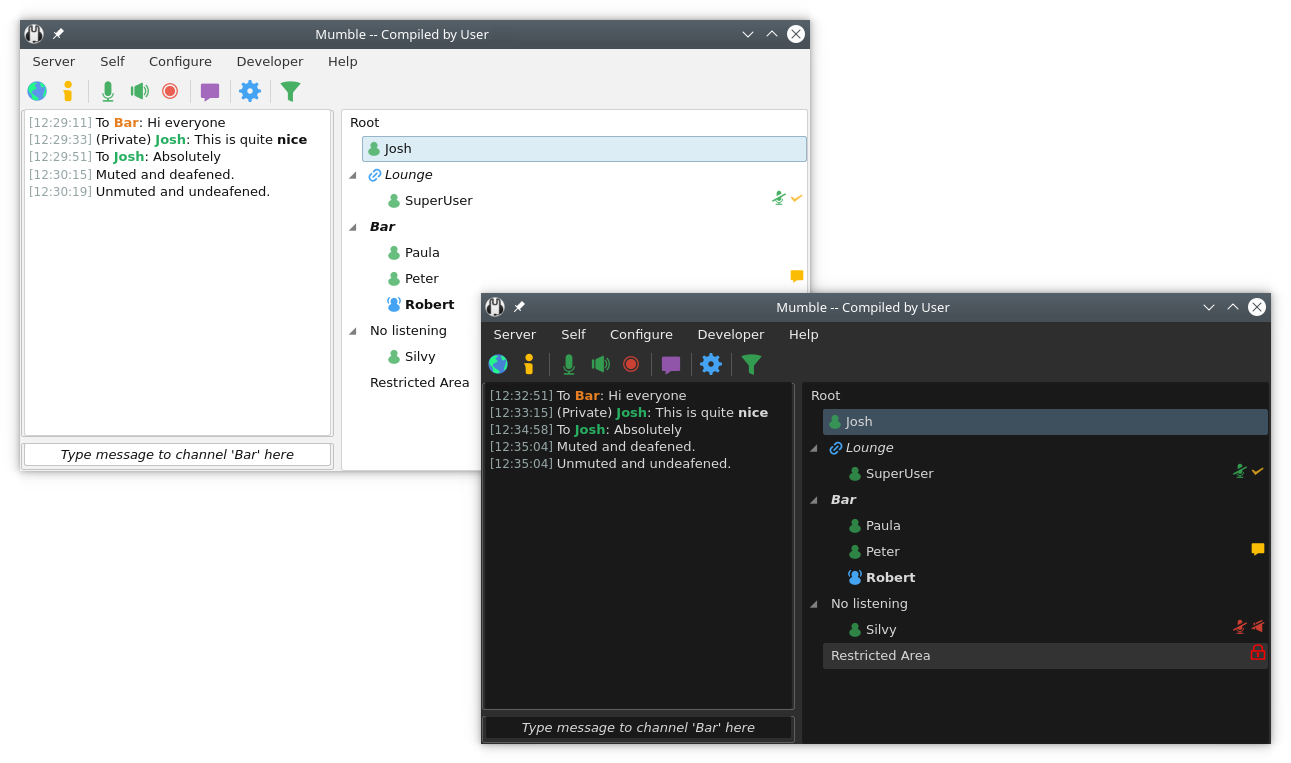Mumble is an Open Source, low-latency and high-quality voice-chat program written on top of Qt and Opus.
There are two modules in Mumble; the client (mumble) and the server (murmur). The client works on Windows, Linux, FreeBSD, OpenBSD, and macOS, while the server should work on anything Qt can be installed on.
The documentation of the project can be found on the wiki. The FAQ can also be found there.
We always welcome contributions to the project. If you have some code that you would like to contribute, please go ahead and create a PR. While doing so, please try to make sure that you follow our commit guidelines.
If you are new to the Mumble project, you may want to check out the general introduction to the Mumble source code.
Mumble supports various languages. We are always looking for qualified people to contribute translations.
We are using Weblate as a translation platform. Register on Weblate, and join our translation project.
Mumble supports general-purpose plugins that can provide functionality that is not implemented in the main Mumble application. You can find more information on how this works and how these have to be created in the plugin documentation.
For information on how to build Mumble, check out the dedicated documentation.
If you want to report a bug or create a feature request, you can open a new issue (after you have checked that there is none already) on GitHub.
We graciously acknowledge that this program uses free code signing provided by SignPath.io, and a free code signing certificate by the SignPath Foundation.
After installation, you should have a new Mumble folder in your Start Menu, from which you can start Mumble.
Double-click the Murmur icon to start Murmur. There will be a small icon on your taskbar from which you can view the log.
To set the superuser password, run murmur with the parameters -supw <password>.
To install Mumble, drag the application from the downloaded
disk image into your /Applications folder.
Murmur is distributed separately from the Mumble client on MacOS. It is called Static OS X Server and can be downloaded from the main webpage.
Once downloaded it can be run in the same way as on any other Unix-like system. For more information please see the "Running Murmur" in the Linux/Unix section below.
If you have installed Mumble through your distribution package repository, you should be able to find Mumble in your start menu. No additional steps are necessary.
Murmur should be run from the command line, so start a shell (command prompt) and go to wherever you installed Mumble. Run murmur as
murmurd [-supw <password>] [-ini <inifile>] [-fg] [v]
-supw Set a new password for the user SuperUser, which is hardcoded to
bypass ACLs. Keep this password safe. Until you set a password,
the SuperUser is disabled. If you use this option, murmur will
set the password in the database and then exit.
-ini Use an inifile other than murmur.ini, use this to run several instances
of murmur from the same directory. Make sure each instance is using
a separate database.
-fg Run in the foreground, logging to standard output.
-v More verbose logging.
On recent Docker versions, you can build images directly from sources on GitHub:
docker build --pull -t mumble-server github.com/mumble-voip/mumble#masterExample --pulls each time to check for updated base image, then downloads and builds master branch.
You can also specify the user ID (UID) and group ID (GID) for the murmur user in the image. This allows users who use bind mount volumes to use the same UID/GID in the container as in the host:
docker build --pull -t mumble-server --build-arg UID=1234 --build-arg GID=1234 github.com/mumble-voip/mumble#masterThe OpenGL overlay works by intercepting the call to switch buffers, and just before the buffer switch, we draw our nice GUI.
To load a game with the overlay enabled, start the game like this:
LD_PRELOAD=/path/to/libmumble.so.1.1 gamenameIf you have Mumble installed through the binary packages, this can be done by simply typing:
mumble-overlay gamename





